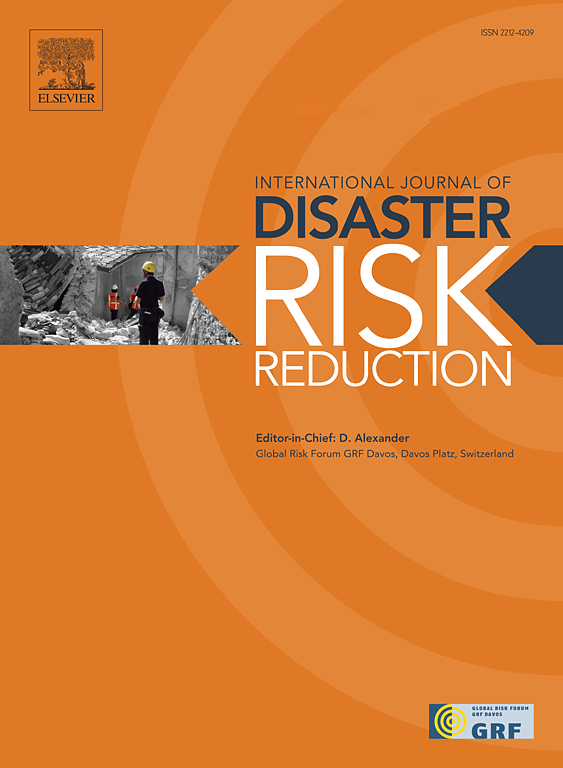A mechanics-based procedure for the structural assessment of infilled RC buildings under overpressures generated by pyroclastic density currents
IF 4.2
1区 地球科学
Q1 GEOSCIENCES, MULTIDISCIPLINARY
International journal of disaster risk reduction
Pub Date : 2025-05-03
DOI:10.1016/j.ijdrr.2025.105546
引用次数: 0
Abstract
The recent seismic activity of the Phlegrean Fields has drawn attention to the potential impact of volcanic eruptions in densely urbanized areas. Among the volcanic processes, the formation of pyroclastic density currents (PDCs) poses a significant threat to residential buildings because of the large dynamic overpressures generated during the explosion. This study introduces a simple mechanics-based method, called STAM-PYR (STructural Assessment Method for PYRoclastic density currents), for the structural assessment of infilled reinforced concrete buildings subjected to PDCs. The STAM-PYR method allows to predict damage evolution as a function of dynamic overpressure intensity, accounting for the contribution of both structural and nonstructural components as well as typical failure modes that can develop in existing RC buildings. Furthermore, it accounts for the variation in the overpressure profile by dynamically updating the load distribution depending on the progressive failure of infill panels and closures. A suitable damage scale is also introduced to facilitate future multi-risk comparisons. The method is exemplified via application to a case study of a typical 1970s RC building, comparing the results to existing literature to demonstrate the enhanced accuracy of the proposed approach in capturing the complex interactions between PDC loadings and building response. STAM-PYR offers a practical and scalable tool to support probabilistic volcanic risk modeling, vulnerability mapping, and emergency planning, especially in urban areas at high risk of explosive eruptions. By enabling a more accurate quantification of structural vulnerability to PDCs, the methodology enhances current capabilities in disaster mitigation, crisis management, and long-term risk-informed land-use strategies.
火山碎屑密度流产生超压下填充RC建筑结构评估的力学基础程序
最近Phlegrean油田的地震活动引起了人们对火山爆发在城市化密集地区的潜在影响的关注。在火山过程中,火山碎屑密度流(PDCs)的形成对住宅建筑构成了重大威胁,因为它在爆炸过程中产生了巨大的动超压。本研究介绍了一种简单的基于力学的方法,称为stamm - pyr(火山碎屑密度电流结构评估方法),用于对受PDCs影响的填充钢筋混凝土建筑进行结构评估。stamm - pyr方法可以预测损伤演变作为动态超压强度的函数,考虑到结构和非结构部件的贡献以及现有RC建筑中可能出现的典型破坏模式。此外,它通过动态更新载荷分布来解释超压剖面的变化,这取决于填充板和闭包的逐渐失效。还引入了一个合适的损害尺度,以便将来进行多风险比较。将该方法应用于一个典型的20世纪70年代RC建筑的案例研究,并将结果与现有文献进行比较,以证明该方法在捕获PDC载荷与建筑响应之间复杂的相互作用方面具有更高的准确性。stamm - pyr提供了一个实用和可扩展的工具,以支持概率火山风险建模、脆弱性绘图和应急规划,特别是在爆炸性喷发高风险的城市地区。通过更准确地量化结构易受PDCs影响的程度,该方法增强了当前在减灾、危机管理和长期风险知情土地使用战略方面的能力。
本文章由计算机程序翻译,如有差异,请以英文原文为准。
求助全文
约1分钟内获得全文
求助全文
来源期刊

International journal of disaster risk reduction
GEOSCIENCES, MULTIDISCIPLINARYMETEOROLOGY-METEOROLOGY & ATMOSPHERIC SCIENCES
CiteScore
8.70
自引率
18.00%
发文量
688
审稿时长
79 days
期刊介绍:
The International Journal of Disaster Risk Reduction (IJDRR) is the journal for researchers, policymakers and practitioners across diverse disciplines: earth sciences and their implications; environmental sciences; engineering; urban studies; geography; and the social sciences. IJDRR publishes fundamental and applied research, critical reviews, policy papers and case studies with a particular focus on multi-disciplinary research that aims to reduce the impact of natural, technological, social and intentional disasters. IJDRR stimulates exchange of ideas and knowledge transfer on disaster research, mitigation, adaptation, prevention and risk reduction at all geographical scales: local, national and international.
Key topics:-
-multifaceted disaster and cascading disasters
-the development of disaster risk reduction strategies and techniques
-discussion and development of effective warning and educational systems for risk management at all levels
-disasters associated with climate change
-vulnerability analysis and vulnerability trends
-emerging risks
-resilience against disasters.
The journal particularly encourages papers that approach risk from a multi-disciplinary perspective.
 求助内容:
求助内容: 应助结果提醒方式:
应助结果提醒方式:


